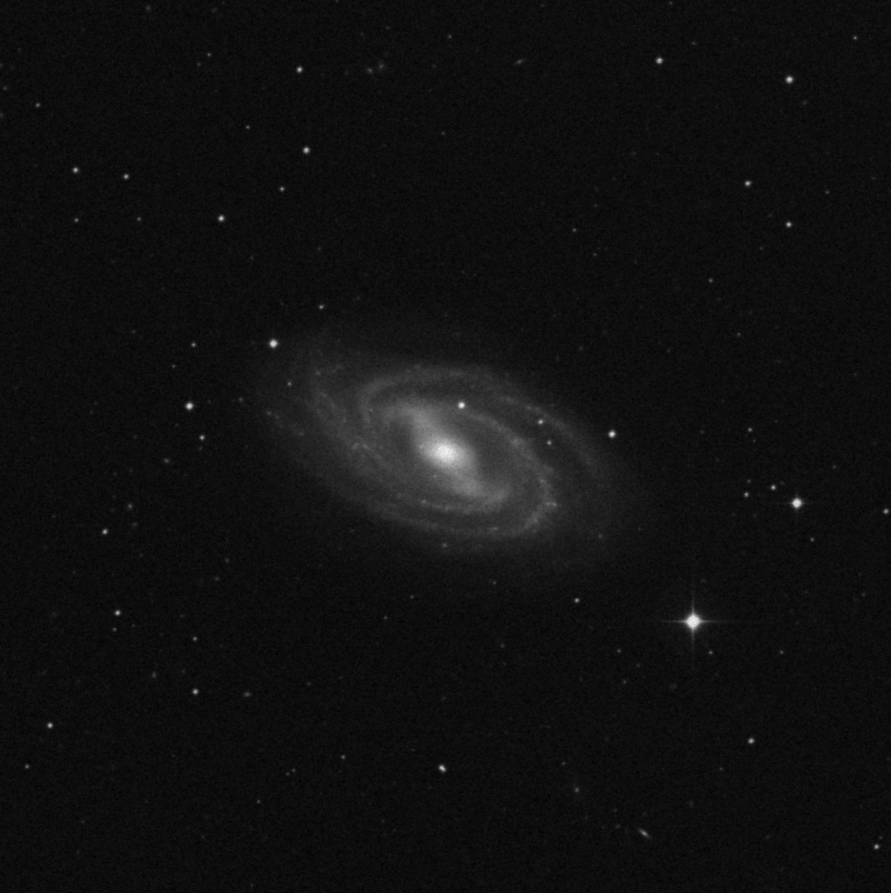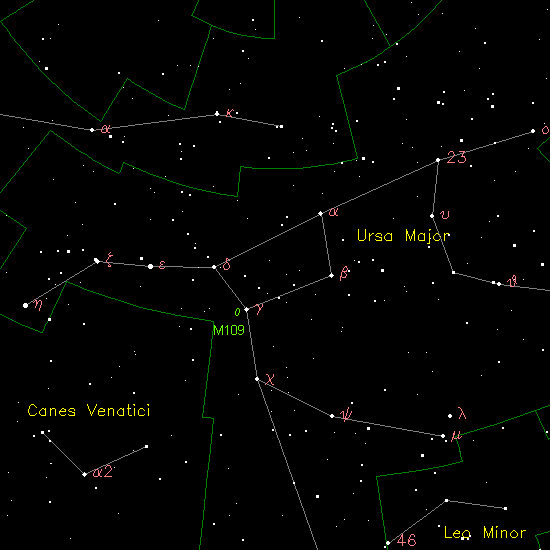Object Name: Messier 109
Alternative Designations: M109, NGC 3992
Object Type: Sbc Barred Spiral Galaxy
Constellation: Ursa Major
Right Ascension: 11 : 57.6 (h:m)
Declination: +53 : 23 (deg:m)
Distance: 55000 (kly)
Visual Brightness: 9.8 (mag)
Apparent Dimension: 7×4 (arc min)
Locating Messier 109: Locating M109 is a snap. It’s position is less than a degree southeast of Gamma Ursae Majoris – Phecda – the inside bottom corner star of the Big Dipper asterism. But just because it is easy to find doesn’t mean it is easy to see! Although it is considered rather large, the outer spiral arms are quite faint and only the bright central bar and nucleus region show well to smaller telescopes. Messier 109 will require dark, clear skies and at least mid-sized aperture to begin seeing details.
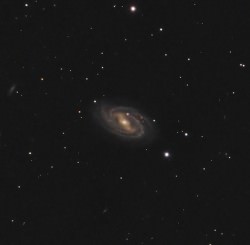 What You Are Looking At: This member of the Ursa Major Galaxy Cloud is about 55 million light years away from Earth and running away from us at an approximate speed of 1142 kilometers per second. However, it is not alone… It has companion galaxies as well – companions that may be contributing to M109’s bright central bar. “Detailed neutral hydrogen observations have been obtained of the large barred spiral galaxy NGC 3992 and its three small companion galaxies, UGC 6923, UGC 6940, and UGC 6969. For the main galaxy, the HI distribution is regular with a low level radial extension outside the stellar disc. However, at exactly the region of the bar, there is a pronounced central H I hole in the gas distribution. Likely gas has been transported inwards by the bar and because of the emptiness of the hole no large accretion events can have happened in recent galactic times.” says R. Bottemar (et al).
What You Are Looking At: This member of the Ursa Major Galaxy Cloud is about 55 million light years away from Earth and running away from us at an approximate speed of 1142 kilometers per second. However, it is not alone… It has companion galaxies as well – companions that may be contributing to M109’s bright central bar. “Detailed neutral hydrogen observations have been obtained of the large barred spiral galaxy NGC 3992 and its three small companion galaxies, UGC 6923, UGC 6940, and UGC 6969. For the main galaxy, the HI distribution is regular with a low level radial extension outside the stellar disc. However, at exactly the region of the bar, there is a pronounced central H I hole in the gas distribution. Likely gas has been transported inwards by the bar and because of the emptiness of the hole no large accretion events can have happened in recent galactic times.” says R. Bottemar (et al).
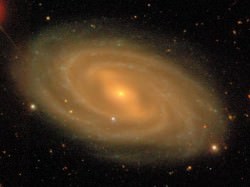 “The gas kinematics is very regular and it is demonstrated that the influence of the bar potential on the velocity field is negligible. A precise and extended rotation curve has been derived showing some distinct features which can be explained by the non-exponential radial light distribution of NGC 3992. The decomposition of the rotation curve gives a slight preference for a sub maximal disc, though a range of disc contributions, up to a maximum disc situation fits nearly equally well. For such a maximum disc contribution, which might be expected in order to generate and maintain the bar, the required mass-to-light ratio is large but not exceptional.”
“The gas kinematics is very regular and it is demonstrated that the influence of the bar potential on the velocity field is negligible. A precise and extended rotation curve has been derived showing some distinct features which can be explained by the non-exponential radial light distribution of NGC 3992. The decomposition of the rotation curve gives a slight preference for a sub maximal disc, though a range of disc contributions, up to a maximum disc situation fits nearly equally well. For such a maximum disc contribution, which might be expected in order to generate and maintain the bar, the required mass-to-light ratio is large but not exceptional.”
 And indeed its spiral structure is what makes it beautiful. Says K. Wilke: “For the intermediate-type barred galaxies NGC 3992 and NGC 7479 stationary models are constructed which reproduce in a consistent manner the observed distribution of the luminous matter and the observed gas kinematics in the inner disk regions affected by the bar. We present 2D fits to the observed NIR luminosity distributions that consist of three components: a bulge, a bar, and a disk. By projection to the reference frame of the galaxy, artificial rotation curves for every model are obtained and are compared with the observed rotation curves of the HII-gas. The parameters of the NGC 3992- and NGC 7479-models are optimized by computing and evaluating a large number of models with different parameter sets. This iterative procedure results in final models that accurately reproduce the morphological structure of NGC 3992 and NGC 7479 as well as the observed kinematics of the HII-gas.”
And indeed its spiral structure is what makes it beautiful. Says K. Wilke: “For the intermediate-type barred galaxies NGC 3992 and NGC 7479 stationary models are constructed which reproduce in a consistent manner the observed distribution of the luminous matter and the observed gas kinematics in the inner disk regions affected by the bar. We present 2D fits to the observed NIR luminosity distributions that consist of three components: a bulge, a bar, and a disk. By projection to the reference frame of the galaxy, artificial rotation curves for every model are obtained and are compared with the observed rotation curves of the HII-gas. The parameters of the NGC 3992- and NGC 7479-models are optimized by computing and evaluating a large number of models with different parameter sets. This iterative procedure results in final models that accurately reproduce the morphological structure of NGC 3992 and NGC 7479 as well as the observed kinematics of the HII-gas.”
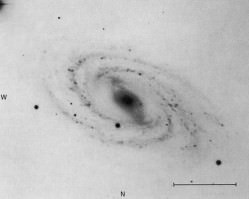 Because Messier 109 has a slightly different structure to its arms, it makes it a great place for astronomers to discover how starforming regions evolve. According to the work of J. P. Cepa and J. E. Beckman: “The present study estimates the efficiency ratio for massive star formation between the arms and the interarm discs of three grand design spirals. The estimate is based on H mapping observations of theHii regions in the galaxies. We find that this efficiency ratio is 10 in the zones between the Lindbalad resonances and the radius which we infer to be co-rotation, dropping to values close to unity at these three resonance raddii. these results point to a dominant influence of resonance structure in stimulating star formation in grand design spirals.”
Because Messier 109 has a slightly different structure to its arms, it makes it a great place for astronomers to discover how starforming regions evolve. According to the work of J. P. Cepa and J. E. Beckman: “The present study estimates the efficiency ratio for massive star formation between the arms and the interarm discs of three grand design spirals. The estimate is based on H mapping observations of theHii regions in the galaxies. We find that this efficiency ratio is 10 in the zones between the Lindbalad resonances and the radius which we infer to be co-rotation, dropping to values close to unity at these three resonance raddii. these results point to a dominant influence of resonance structure in stimulating star formation in grand design spirals.”
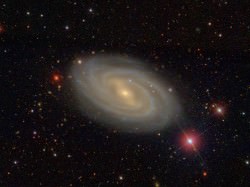 However, Messier 109 isn’t just producing new stars. It’s magnetic halo is producing ultra high energy cosmic rays! “The study of the propagation of ultra-high-energy cosmic rays (UHECRs) is a key step to unveiling the secret of their origin. Up to now only the influence of the galactic and extragalactic magnetic fields was considered. In this article we focus our analysis on the influence of the magnetic field of the galaxies standing between possible UHECR sources and us. Our main approach is to start from the well-known galaxy distribution up to 120 Mpc.” says Pascal Chardonnet and Alvise Mattei. “We use the most complete galaxy catalog: the LEDA catalog. Inside a sphere of 120 Mpc, we extract 60,130 galaxies with known positions. In our simulations we assign a halo dipole magnetic field (HDMF) to each galaxy. The code developed is able to retro-propagate a charged particle from the arrival points of UHECR data across our galaxy sample. We present simulations in the case of the Virgo Cluster and show that there is a nonnegligible deviation in the case of protons of 7 × 1019 eV, even if the B value is conservative. Then special attention is devoted to the AGASA triplet, where we find that NGC 3998 and NGC 3992 could be possible source candidates.”
However, Messier 109 isn’t just producing new stars. It’s magnetic halo is producing ultra high energy cosmic rays! “The study of the propagation of ultra-high-energy cosmic rays (UHECRs) is a key step to unveiling the secret of their origin. Up to now only the influence of the galactic and extragalactic magnetic fields was considered. In this article we focus our analysis on the influence of the magnetic field of the galaxies standing between possible UHECR sources and us. Our main approach is to start from the well-known galaxy distribution up to 120 Mpc.” says Pascal Chardonnet and Alvise Mattei. “We use the most complete galaxy catalog: the LEDA catalog. Inside a sphere of 120 Mpc, we extract 60,130 galaxies with known positions. In our simulations we assign a halo dipole magnetic field (HDMF) to each galaxy. The code developed is able to retro-propagate a charged particle from the arrival points of UHECR data across our galaxy sample. We present simulations in the case of the Virgo Cluster and show that there is a nonnegligible deviation in the case of protons of 7 × 1019 eV, even if the B value is conservative. Then special attention is devoted to the AGASA triplet, where we find that NGC 3998 and NGC 3992 could be possible source candidates.”
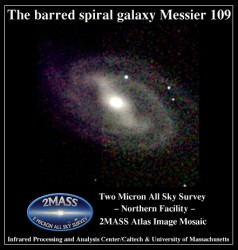 But things aren’t sitting still inside Messier 109 while the action goes on. The central bar is rotating rather unusually, too. “The pattern speed is one of the fundamental parameters that determines the structure of barred galaxies. This quantity is usually derived from indirect methods or by employing model assumptions. The number of bar pattern speeds derived using the model-independent Tremaine & Weinberg technique is still very limited. We present the results of model-independent measurements of the bar pattern speed in four galaxies ranging in Hubble type from SB0 to SBbc.” says Joris Gerssen (et al). “Three of the four galaxies in our sample are consistent with bars being fast rotators. The lack of slow bars is consistent with previous observations and suggests that barred galaxies do not have centrally concentrated dark matter haloes. This contradicts simulations of cosmological structure formation and observations of the central mass concentration in nonbarred galaxies.”
But things aren’t sitting still inside Messier 109 while the action goes on. The central bar is rotating rather unusually, too. “The pattern speed is one of the fundamental parameters that determines the structure of barred galaxies. This quantity is usually derived from indirect methods or by employing model assumptions. The number of bar pattern speeds derived using the model-independent Tremaine & Weinberg technique is still very limited. We present the results of model-independent measurements of the bar pattern speed in four galaxies ranging in Hubble type from SB0 to SBbc.” says Joris Gerssen (et al). “Three of the four galaxies in our sample are consistent with bars being fast rotators. The lack of slow bars is consistent with previous observations and suggests that barred galaxies do not have centrally concentrated dark matter haloes. This contradicts simulations of cosmological structure formation and observations of the central mass concentration in nonbarred galaxies.”
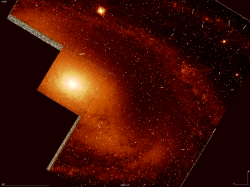 When it comes to galaxy dynamics, it is this speed that determines the bulge in the center. Says E. M. Corsini: “The dynamics of a barred galaxy depends on the pattern speed of its bar. The only direct method for measuring the pattern speed of a bar is the Tremaine-Weinberg technique. This method is best suited to the analysis of the distribution and dynamics of the stellar component. Therefore it has been mostly used for early-type barred galaxies. Most of them host a classical bulge. On the other hand, a variety of indirect methods, which are based on the analysis of the distribution and dynamics of the gaseous component, has been used to measure the bar pattern speed in late-type barred galaxies. Nearly all the measured bars are as rapidly rotating as they can be. By comparing this result with high-resolution numerical simulations of bars in dark matter halos, it is possible to conclude that these bars reside in maximal disks.”
When it comes to galaxy dynamics, it is this speed that determines the bulge in the center. Says E. M. Corsini: “The dynamics of a barred galaxy depends on the pattern speed of its bar. The only direct method for measuring the pattern speed of a bar is the Tremaine-Weinberg technique. This method is best suited to the analysis of the distribution and dynamics of the stellar component. Therefore it has been mostly used for early-type barred galaxies. Most of them host a classical bulge. On the other hand, a variety of indirect methods, which are based on the analysis of the distribution and dynamics of the gaseous component, has been used to measure the bar pattern speed in late-type barred galaxies. Nearly all the measured bars are as rapidly rotating as they can be. By comparing this result with high-resolution numerical simulations of bars in dark matter halos, it is possible to conclude that these bars reside in maximal disks.”
History: This interesting spiral galaxy was first turned up by Pierre Mechain on the night of March 12, 1781. It was later confirmed by Charles Messier on March 24, 1781, along with M108 while doing the computations for M97. Originally Messier included this finding as object #99 is his rough draft, but did not give it a position. From Mechain’s letter to Bernoulli of May 6, 1783: “A nebula near Beta in the Great Bear. Mr. Messier mentions, when indicating its position, two others, which I also have discovered and of which one is close to this one [M108], the other is situated close to Gamma in the Great Bear [this is M109], but I could not yet determine their positions.”
Because it wasn’t included in the catalog, Sir William Herschel independently recovered it on on April 12, 1789, gave it his own catalog number and writes: “Considerably bright. Irregularly formed. Extended meridionally [along the Meridian, i.e. North-South]. Little brighter Nucleus. With faint brances 7 or 8′ long, and 5 or 6′ broad.” His son John would also go on to add it to his catalog on February 17, 1831 when he writes: “Bright; Large; very suddenly brighter to the Middle; round; 3′ diameter. Fine object.”
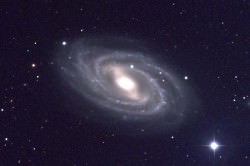 Because M109 wasn’t added to the published Messier catalog of the time, poetic stargazer – Admiral Smyth – would attribute its discovery to Herschel and write in his own notes: “A large pale-white nebula, on the Bear’s right haunch, about 1d 1/4 south of Gamma; discovered in April, 1789. It has a peculiar appearance in the field, from there being a coarse small double star north of it, and from its being followed by a vertical line of five equidistant telescopic stellar attendants. This object is fine, but, in my instrument, faintish; it brightens towards the middle; and WH says there is, in that part, an unconnected star, the which I cannot make out. From every inference this nebula is a vast and remote globular cluster of worlds, for JH assures us it is actually resolvable. By its blazing towards the centre, proof is afforded that the stars are more condensed there than around its margin, an obvious indication of a clustering power directed from all parts towards the middle of the spherical group. In other words, the whole appearance affords presumptive evidence of a wonderful physical fact, — the actual existence of a central force.”
Because M109 wasn’t added to the published Messier catalog of the time, poetic stargazer – Admiral Smyth – would attribute its discovery to Herschel and write in his own notes: “A large pale-white nebula, on the Bear’s right haunch, about 1d 1/4 south of Gamma; discovered in April, 1789. It has a peculiar appearance in the field, from there being a coarse small double star north of it, and from its being followed by a vertical line of five equidistant telescopic stellar attendants. This object is fine, but, in my instrument, faintish; it brightens towards the middle; and WH says there is, in that part, an unconnected star, the which I cannot make out. From every inference this nebula is a vast and remote globular cluster of worlds, for JH assures us it is actually resolvable. By its blazing towards the centre, proof is afforded that the stars are more condensed there than around its margin, an obvious indication of a clustering power directed from all parts towards the middle of the spherical group. In other words, the whole appearance affords presumptive evidence of a wonderful physical fact, — the actual existence of a central force.”
Although he didn’t know he was looking at a distant galaxy, Smyth definitely had some sort of clue as to what was going on. May your observations prove as interesting!
Top M109 image credit, Palomar Observatory courtesy of Caltech, M109 Images courtesy of SSDS, M109 courtesy of Hunter Wilson (Wikipedia), M109 IPAC Image, M109 Core Region courtesy of NASA/ESA Hubble Space Telescope, M109 2MASS Image and M109 image courtesy of NOAO/AURA/NSF.

